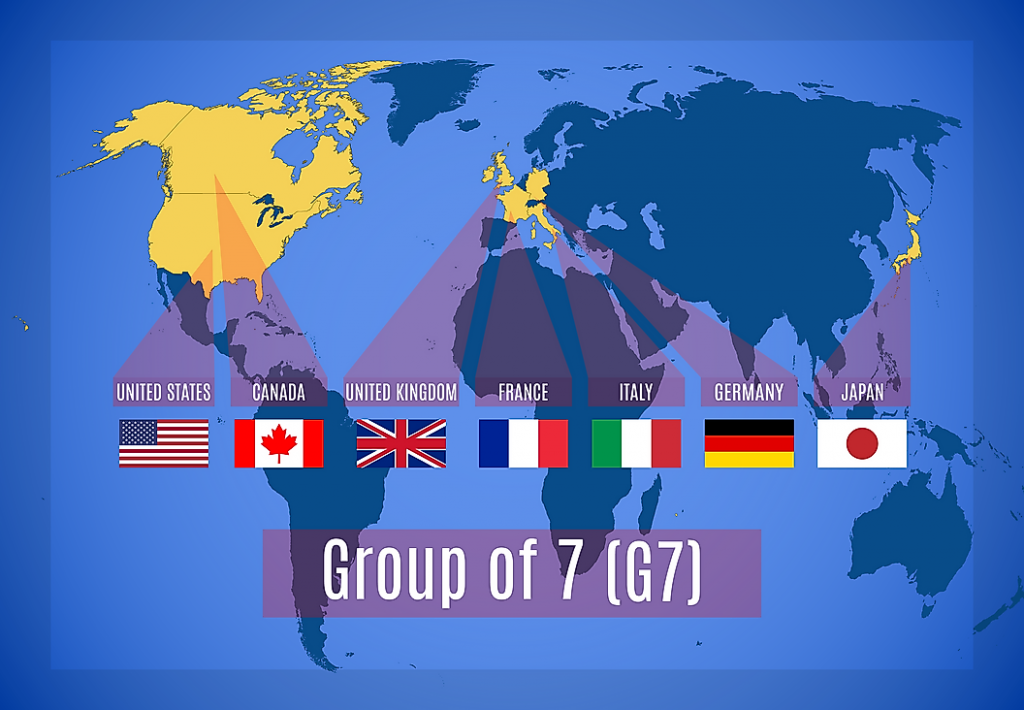Context:
G-7 leaders finally came around with the proposed Build Back Better World (B3W) to counter China’s rising influence across 100-plus countries through Belt Road Initiative (BRI) projects.
Relevance:
GS-II: International Relations (India and its Neighborhood, Effect of Policies & Politics of Countries on India’s Interests, Important International Groupings affecting India’s Interests)
Dimensions of the Article:
- What is the G7?
- History of the G7
- About the Build Back Better World (B3W)
- Significance of B3W
What is the G7?
- The Group of 7 (G7) is an informal group of seven countries — the United States, Canada, France, Germany, Italy, Japan and the United Kingdom, the heads of which hold an annual summit with European Union and other invitees.
- Together the member countries represent 40% of global GDP and 10% of the world’s population.
- Unlike other bodies such as NATO, the G7 has no legal existence, permanent secretariat or official members.
- It also has no binding impact on policy and all decisions and commitments made at G7 meetings need to be ratified independently by governing bodies of member states.
- The major purpose of the G-7 is to discuss and deliberate on international economic issues.
- G7 is capable of setting the global agenda because decisions taken by these major economic powers have a real impact. Thus, decisions taken at the G7 are not legally binding, but exert strong political influence.
- It sometimes acts in concert to help resolve other global problems, with a special focus on economic issues.


History of the G7
- A meeting between the current G7 members, excluding Canada, in 1975 laid the basis for the formation G7. At the time, the global economy was in a state of recession due to the OPEC oil embargo.
- As the energy crisis was escalating, the then US Treasury Secretary decided that it would be beneficial for the large players on the world stage to coordinate with each other on macroeconomic initiatives.
- After this first summit, the countries agreed to meet annually and a year later, Canada was invited into the group which marked the official formation of the G7 as we know it.
- The President of the European Commission was asked to join the meetings in 1977 and following the collapse of the Soviet Union in 1991 and a subsequent thaw in relations between the East and West, Russia was also invited to join the group in 1998. Thereafter the group was named the G8 until 2014, when Russia was expelled for its annexation of Crimea from Ukraine.
- The presidency of G7 meetings is held by each of the seven countries in turn, each year. The country holding the presidency is responsible for organising and hosting the meeting.
About the Build Back Better World (B3W)
- The B3W aims to address the infrastructure investment deficit in developing and lower income countries – the space which has been increasingly captured by China through 2,600 BRI projects with trillions of dollars of investment.
- The overall focus is on developing transportation, logistics and communications, which would reduce trade and transaction cost for China’s trade, give more market access to Chinese markets and ensure stable supply of energy and other resources.
- B3W initiative will provide a transparent infrastructure partnership to help narrow about $40 trillion needed by developing nations by 2035.
- It calls for spending hundreds of billions of dollars in collaboration with the private sector while adhering to climate standards and labour practices.
- However, the announcement is yet to be made about how exactly the plan would work or how much capital it would ultimately allocate.
Significance of B3W
- The re-emergence of China as a leading global power is considered to be one of the most significant geo-political events of recent times, alongside the 1991 fall of the Soviet Union that ended the Cold War.
- China in 1979 had an economy that was smaller than Italy’s, but after opening to foreign investment and introducing market reforms, it has become the world’s second-largest economy and is a global leader in a range of new technologies.
- However, the West had failed to offer a positive alternative to the “lack of transparency, poor environmental and labour standards, and coercive approach” of the Chinese government that had left many countries worse off.
-Source: Indian Express




